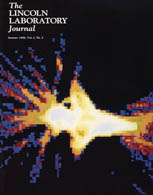Publications
Volume 2, Number 2
 |
|
Tomographic Techniques Applied to Laser Radar Reflective Measurements Methods of tomography are applied to laser radar reflective measurements to study remote imaging of macroscopic objects. Techniques to produce 2-D images from I-D data and 3-D images from 2-D data are described, and examples are shown. The data are the received signals from laser radars, resolved in either I-D (range or Doppler) or 2-D (angle-angle) and taken from many viewing directions. Examples are presented of reconstructed images of laboratory test objec1s obtained with infrared and visible laser radars. Each reconstructed image depicts the object's geometric features. Prospects for future applications are discussed. Dynamic Error Compensation of Analog-to-Digital Converters Analog-to-digital converters (ADC) produce nonlinear distortion in the digitization of an applied signal. Spurious signal components produced by ADC distortion mask low-amplitude applied signal components. As a result, ADC distortion limits the achievable dynamic range in many high-performance digital communication systems. Limitations imposed by current ADC technology dictate the bandwidth or dynamic range performance of both new and existing systems. We describe a dynamic error-correction technique that significantly reduces the level of nonlinear distortion observed in a digitized signal. The technique, called phase-plane compensation, corrects the ADC output samples by using a two-dimensional lookup table. The table accounts for both static and dynamic error sources within the ADC. Several applications of phase-plane compensation to commercially available ADCs are described. One example yields a dynamic range improvement of 15 dB (more than 2 bits) over an input frequency range spanning 4 MHz. The examples highlight the strengths of the technique and topics for further investigation. Using Molecular-Beam Epitaxy to Fabricate Quantum-Well Devices Recent advances in thin-film crystal-growth techniques such as molecular-beam epitaxy (MBE) have enabled the fabrication of quantum-well devices, which consist of alternating layers of various crystalline solid materials so thin that the materials' combined quantum-mechanical properties override their individual bulk properties. By using MBE, we constructed a number of quantum-well devices that have applications in ultrahigh-speed analog, digital, and electro-optical integrated and hybrid systems. Speckle Imaging through the Atmosphere The atmosphere is the limiting factor in high-resolution ground-based optical telescope observations of objects in space. New speckle-imaging techniques allow astronomers to overcome atmospheric distortion and achieve the goal of diffraction-limited ground-based telescope performance. Studies and experiments at Lincoln Laboratory utilize speckle imaging for observation of near-earth satellites. Thousands of separate exposures, each 2 to 5 ms in duration, are collected within a few seconds. A computationally intensive algorithm is then used to reconstruct a single diffraction-limited image from the collection of separate exposures. The image-reconstruction process effectively removes the distortion imposed by the atmosphere. Photon noise, which limits the quality of image reconstruction, must be properly compensated by the actual detector calibration. An Interactive Plotting and Data-Analysis Package for the IBM PC The Personal Computer Resource Center at Lincoln Laboratory has developed a plotting program called EasyPlot to display and analyze technical data on IBM Personal Computers. The program offers researchers a fast, interactive, graphical user interface that creates an intuitive environment for quickly viewing, analyzing, and plotting data. This article describes the program and some interesting design techniques that enhance program speed. Colonel Richard's Game "Colonel Richard's Game," a two-person zero-sum game, is introduced. The game is a variant of the popular "Colonel Blotto's Game," which we will discuss first. Solutions to Colonel Richard's Game are presented and discussed. The Kiernan Reentry Measurements System on Kwajalein Atoll The Kiernan Reentry Measurements System (KREMS),located on Kwajalein Atoll in the Pacific, is the United States' most sophisticated and important research and development (R & D) radar site. Consisting of four one-of-a-kind instrumentation radars, KREMS has played a major role for the past 25 years in the collection of data associated with ICBM testing. Furthermore, it has served as an important space-surveillance facility that provides an early U.S. view of many Soviet and Chinese satellite launches. Finally, the system is slated to play a key role in Strategic Defense Initiative (SDI) experiments. Machine Intelligence Technology for Automatic Target Recognition Automatic target recognition (ATR)—the use of computer processing to detect and identify targets automatically—is becoming critically important in several military applications. ATR systems can reduce the workload of tactical aircraft crews and decrease the communication bandwidth that remotely piloted vehicles need. ATR will also be a crucial component of future "smart" weapons, missiles programmed to seek out and destroy specified targets. Furthermore, ATR technology has potential commercial application in the field of robotic vision. The development of a comprehensive ATR system is difficult because the system must handle a variety of targets under a variety of conditions. By using techniques from the field of artificial intelligence, often called machine intelligence, we have developed an experimental ATR system that processes image data from a laser radar and then automatically detects and recognizes specified targets in the data. The system has performed well with real-life and synthetic data. |
|